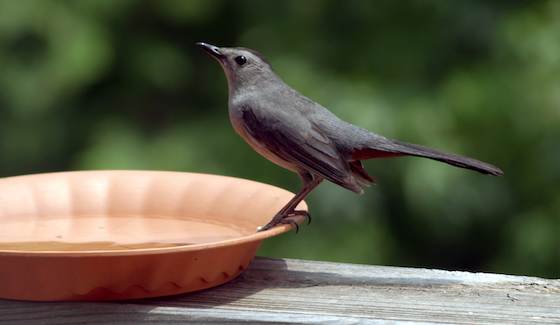By Sean Conway

Avian insect eaters, such as the catbird, are easily lured to nest in your backyard by installing a small fountain
One of my favorite things about sitting outside during the summer is watching all the bird activity in our yard.
We have a lot of mature trees on our property, and the house is situated at one end of a reservoir that is close to a mile long and half as wide. Between our house and the pond lies a beautiful marsh filled with cattails and other assorted wetland plants. A stream flows through the marsh, emptying into the reservoir and providing a watery highway of sorts for a variety of birds.
At any given moment during the day, dozens of tree swallows and barn swallows can be seen slicing through the air just above the marsh with the grace of Olympic figure skaters.
Barn swallows dine exclusively on insects, and they hunt on the wing. I like to think that, without the barn swallows, the mosquito population would be out of control. But the truth is, after 9 p.m. the mosquitoes are pretty close to unbearable, so either the swallows are going to have to start eating more or I'm going to have to put up another barn to attract more swallows.
There are other birds that help keep the insect population on our property in check, and I am quite certain that they are responsible for reducing the number of insect pests that plague my vegetable garden.
Song sparrows, catbirds and goldfinches are constantly flying in and out of my vegetable garden. They are attracted to the sound of running water from the fountain in the center of the garden. While there, they seem to help themselves to the always-present insects that enjoy munching on my vegetables.
The great thing about having a varied avian population on your property is that during the summer months most birds have nests full of hungry mouths to feed, and the majority feed their young a diet of high-protein insects. The more nesting birds you have, the fewer insects you will have.
Some people keep their birdfeeders filled during the summer months to attract birds to their yards. I prefer to use running water. I find that the sound of running water attracts a greater variety of birds than birdfeeders do, especially during the hot, dry months of July and August.
The one feeder I do keep filled, however, is my thistle feeder. Thistle seed, often called nyjer seed, is a favorite food of goldfinches. Their bright yellow and black plumage, cheerful demeanor, and he fact that they travel in small flocks livens up my garden and provides hours of enjoyment.
Goldfinches are adept at eating the small, high-fat, high-energy thistle seed better than most birds, and they pretty much have the feeders to themselves.
Here are a few tips for attracting more birds to your garden this summer:
-- Add a small fountain with running water. The sound of running or dripping water will attract numerous species for a bath or a quick drink. Kits for deck railing fountains are available and work well too.
-- Consider adding a thistle feeder. These tube-shaped feeders can be easily hung from shepherd hooks in perennial borders or at the edge of shrubs. Birds such as goldfinches, purple finches and chickadees will frequent these feeders to get the energy-packed seed.
-- For an alternative type of feeder, try placing grape jelly on a flat dish at the edge of your porch or deck. Birds like catbirds and Orioles relish the sweet treat and will be frequent visitors once they discover it.
Attracting more birds to your yard will provide colorful activity for you to enjoy, while helping to rid your garden of leaf-chomping insect pests.
Available at Amazon.com:
Cut Your Energy Bills Now: 150 Smart Ways to Save Money & Make Your Home More Comfortable & Green
It's Easy Being Green: A Handbook for Earth-Friendly Living
Sean Conway's Cultivating Life: 125 Projects for Backyard Living
© SEAN CONWAY. DISTRIBUTED BY Tribune Media Services
AUTOS | HOBBIES | EDUCATION | FAMILY | FASHION | FOOD & RECIPES | HOME DECOR | RELATIONSHIPS | PARENTING | PETS | TRAVEL | WOMEN
Home & Garden - Insect Control Is for the Birds